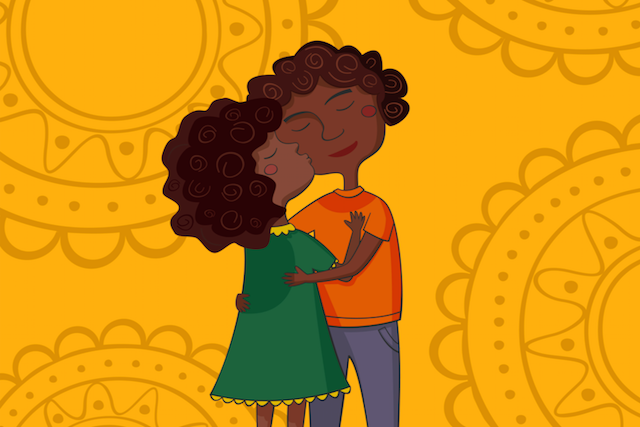
“Sorry isn’t always enough. Sometimes you actually have to change.” ~Unknown
When I was young I was like every other kid, always in and out of trouble. I pushed the boundaries of what was acceptable in order to see what I could get away with. When I pushed, I’d often keep on pushing until someone said “stop.”
During my childhood I heard lots of:
“STOP!!”
Quickly followed by:
“Say you’re sorry.”
Say those two magical words, “I’m sorry,” and all the pain will go away. Then I’ll be back in the good books and can go play with my friends again.
During this time I received another strong message that many children hear. It’s the one that says some of your feelings are not a good thing. That’s because I was told:
Don’t look sad.
Don’t cry.
Don’t be scared.
This led to me feel guilt and even shame about the expression of certain feelings. As a result, over time I was less able to acknowledge feelings in myself and others. These two elements, when combined years later, went on to cause real problems for me. This is because I was now in front of an angry partner and I went back to what I learned as a child.
I repressed my feelings, tried to look sad, and said “I’m sorry.”
This time, however, I wasn’t speaking to my parents. It was my partner who was very sensitive to the fact that the words alone weren’t enough.
My apology now created more harm than good, and I didn’t have a clue what to do about it. My relationships suffered for years, as we would both regress back to childhood archetypal patterns of behavior. This is where we’d indulge in hierarchical relationships, playing out childhood habits with the husband/wife dynamic expressed as mother/son or father/daughter. This killed the trust and intimacy in our relationship, and was a fast track to either breakup, or long-term dissatisfaction and resentment.
In one particularly fractious relationship I remember always saying sorry because I thought it was what my partner wanted me to say. I knew that she thought she was right, and therefore I must be wrong. We didn’t have the skills to navigate ourselves to a mutually agreeable resolution, so the shortcut to a life of harmony was for me to accept that I was wrong.
Based on what I learned as a child, saying sorry was the natural response. It seemed to be by far the easiest way to resolve our differences, but it didn’t work. The hierarchy this created ultimately ended that relationship, as I failed to communicate with my partner on the equal footing we both needed for it to work.
How I’d learned to behave all those years ago clearly wasn’t working, and I desperately needed an alternative to manage the difficult conversations I was now having in my relationships.
As I moved from relationship to relationship I managed to work through this and developed new skills that helped me grow and heal the wounds from my past. These new skills required me to access the very emotions I was encouraged to repress when I was young and helped me create the connection, trust, and safety my relationship craved.
Assuming you’re in a non-abusive, healthy relationship, there is an alternative, and is something I now practice almost every day. Here are four steps you can follow the next time you find yourself about to utter the dreaded words “I’m sorry”:
Step 1: Slow down, acknowledge what’s happened, and take responsibility for your part in it.
In any relationship there is 200% responsibility to be split 50/50 between both people. Problems happen when the split isn’t equal and people either take too little responsibility (i.e.: the victim) or too much (i.e.: the co-dependent).
Developing an honest, open, trusting relationship starts with ensuring you take 100% responsibility for what is yours to take, and no more. By doing this you can create a clear line between what is yours and what is not. This then empowers your partner to do the same.
A while back I noticed how my relationship had become strained, and I felt as if I was either saying “I’m sorry” to my partner, or she was expecting me to. I had been trying to resolve the problems we were having by looking outside of myself and blaming my partner; so I decided to turn things 180 degrees. I looked at myself, got honest, took responsibility, and I told my partner.
I told her that I had noticed things were strained and I was committed to doing something about it. I explained that I had been projecting lots of beliefs on to her about her not being good enough. These were beliefs I held about myself, and it wasn’t fair to project these on to her. I apologized for doing that and said I was taking my judgments back and owning them.
Taking responsibility in our lives is key to developing positive relationships of trust and intimacy where there was previously victimhood and blame. Even when you think others haven’t noticed your victimhood, they have. People notice when you are projecting onto them, and they can feel the difference when you stand powerfully in your truth and take full responsibility for your actions.
Step 2: Describe your feelings regarding what happened. Speak honestly and share what comes up for you.
Feelings can be used as weapons in relationships in order to apportion blame, such as claims like:
“You made me feel like this.”
But when we connect to our own feelings, take responsibility for what we feel, and honestly communicate them to others, we provide a platform for connection. From this place of vulnerability we stop being like teflon, with everything sliding off us, and instead become sticky and able to create bonds and connection with our partners.
When I took responsibility for the problems in my relationship I shared how I felt. I explained how I was embarrassed about how I’d behaved. I shared how I was scared what she might think of me for being so honest, and I was sad that I hadn’t managed to open up about it sooner.
Think of the times in your life when you really bonded with your friends or partner. This happens during times of high emotion, both the good and bad. It’s easy to bond and create connection during periods of high emotion and good mood. It takes a lot more to use more difficult emotions to create deep connection. However, it’s these emotions and the vulnerability that we bring to them, where the deepest connections are made.
Step 3: Empathize by sharing what feelings and emotions they must have felt in response to what happened.
When we say “I’m sorry” it encourages us to access the situation from our perspective and via our feelings and emotions. In order for our words to be heard we need to demonstrate that we truly understand our partner’s world and not just our own. For that, we need empathy.
Empathy is a difficult skill because it requires us to recognize the uncomfortable feelings our partner is feeling. It also requires us to access those feelings within ourselves, and then reflect them back to our partner. Lack of empathy is a symptom of us not wanting, or able, to be vulnerable to others’ difficulties because of the way their feelings will make us feel. That’s why it’s important for us to get more familiar with the full range of our emotions, and not just the “good” ones.
Here are two quick tips to help you to develop more empathy. Firstly, start with the sentence string “I imagine…” This is because it encourages you to enter your partner’s world for a moment. It encourages you to get out of your point of view and see things with fresh eyes. For example: “I imagine you must be feeling really angry and sad about what happened.”
Secondly, notice your tendency to blame and judge. Judgment is the antithesis of empathy and should be avoided at all costs.
Step 4: Validate your partner by telling them that what they have shared makes logical sense to you, and why.
For reasons I am yet to fathom, we are guilt- and shame-creating machines. We love to make ourselves feel bad about what we do and create doubt about what we feel. That’s why being validated for what we feel is so important.
The reality is we don’t have any choice about what we feel. Something happens and our body, mind, and soul respond in a certain way that’s beyond our control. We can’t select the positive emotions we want to feel in response to what’s happened and avoid the ones we dislike.
Deep down we judge ourselves for whether our response is right/wrong or good/bad. So being told that our response makes complete sense helps us feel accepted and seen. To be told why it makes sense is like the cherry on top of the cake. It helps us feel as if someone really understands us and sees us for who we really are and how we really feel.
—
The intention behind saying “I’m sorry” is focused on yourself. Its primary intention is to get a quick resolution to the problem, and move on. However, the intention behind this alternative approach above is focused on your partner. This time the primary intention is to demonstrate that you understand them and to own your part in what happened.
Apologizing and clearing resentments are two of the most important skills you can learn in a relationship. No one taught us how to do this, so instead we can regress to childhood habits in order to navigate these delicate areas. As I look back to when I started applying these changes in my relationship I’m amazed what a powerful impact it had on me and my partner.
Coming from this new place felt freeing and very powerful. Instead of apologizing and feeling lesser or smaller, I stood taller like some weight had been lifted from my shoulders.
The impact it had on my partner was huge. She now felt seen, understood, prioritized, and safe. She trusted me again in a much deeper way than before. That’s because when we take responsibility and apologize in this deeper way it frees us of our burdens and makes us feel more authentic and real, as a result. This can help us to use conflict in our relationship to actually improve and deepen connection and that’s a skill we could all do with.
About Mike Matthews
Mike is a writer, coach and founder at The Inspiring Men Project. He helps men and women to understand each other better and men to understand themselves so they can take their relationships and lives to the next level. Connect with Mike and get his eBook Boundaries, How Healthy Boundaries Can Improve Your Life and Save Your Relationship, here.













 Though I run this site, it is not mine. It's ours. It's not about me. It's about us. Your stories and your wisdom are just as meaningful as mine.
Though I run this site, it is not mine. It's ours. It's not about me. It's about us. Your stories and your wisdom are just as meaningful as mine. 